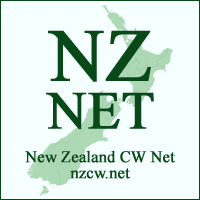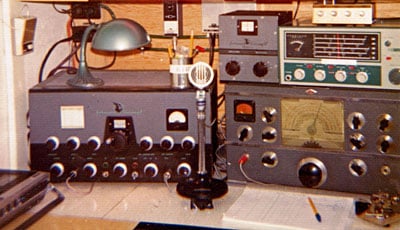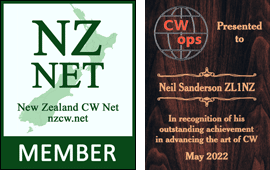 By Neil ZL1NZ
By Neil ZL1NZ
When I started the NZ Net in March 2019, I had three aims:
1. To encourage CW operation
2. To provide training and experience in CW net operation
3. To provide training and experience in CW message handling
At that time, there were several slow-speed CW “training” nets in New Zealand, but nothing to train and develop the more advanced operator.
CW ragchewing was rare, and the few New Zealand amateurs who knew Morse tended to use it for working DX and contesting only. Unfortunately, this required little more than sending “5NN TU”.
As well, the concept of traffic handling was not well-known in New Zealand, as radio amateurs here had not been permitted to handle 3rd party traffic until well into the modern era of cheap long-distance calls, mobile phones and the internet – by which time the general public had no need for amateur radio message services.

My station in the early 1970s, fully equipped for multi-mode traffic handling with QSK and PTT,
Traffic handling appeals to me for a couple of reasons:
- Traffic handling is accessible to all CW ops, because it isn’t about speed, although it is excellent training for those who want to increase their speed. Rather, it is about accuracy and precision. If you don’t copy something perfectly, you simply ask the sending operator for a “fill” and you keep doing that until you can QSL with confidence. Nobody gets impatient if you ask for fills. Rather, it is a sign that you are committed to getting the message word-perfect. The sending and receiving of traffic is a true partnership between the operators.
- This focus on precision is also reflected in the operation of good CW net, whether or not it handles traffic. Listening to a high-functioning CW net is pure joy to me. The communication between stations is crisp and unambiguous. We use the Q Signals, because they save heaps of time. Traffic gets handled efficiently and when the “work” is done, Net Control closes the net and the friendly chatter between ops often fills the frequency.
In 2015, about 45 years after my early exposure to CW nets, I ran across a small group of Australian amateurs running a traffic net. I joined in, and my enthusiasm for traffic nets was quickly rekindled. Moreover, the experience was even better than I remembered. The leader of the VKCW group, Lou VK5EEE, had refined the net system and radiogram formats, incorporating some of the approaches used in commercial and maritime services. Lou’s ideas made sense to me, and I began checking in regularly on the 80, 40 and 20-metre nets.
Unfortunately, propagation was often poor (although this was a great opportunity to practise weak signal copying, which can be surprisingly successful). I wished, however, that we could have a CW net where the signals would all be good (e.g. covering all of New Zealand on 80 metres) and we could focus on developing the other skills mentioned at the top of this page.
In February 2019 I sent out an online survey to people who had participated in the New Zealand Straight Key Night, which I manage. As well as questions about improving SKN, I threw out the idea of a CW Net that might include some traffic handling. Eight operators expressed interest, and information about the proposed NZ Net was then shared with the New Zealand FISTS email list (thanks to David ZL2WT, the coordinator of the FISTS Downunder group in NZ). The FISTS email elicited an enthusiastic response from Dave ZL4LDY, who had moved to New Zealand from the USA many years ago. Like me, Dave cut his ham radio teeth on NTS nets, and was even still checking into some via remote stations in the USA.
The net begins
I opened our first net on 25 March 2019 at 2100 hours local time on 3535 kHz. I wondered if anyone would answer my “CQ NZ NET” and so it was a pleasure to receive calls from VK3DRQ, ZL2GD, ZL4LDY and ZL4OL. For the first few weeks, Dave and I took turns as Net Control Station. Our Net Control operators would soon include Grant ZL2GD, Steve ZL2KE and Gerard ZL2GVA.
We cleared three pieces of formal traffic that first week, which I thought was a pretty good start.
I published the first edition of NZ Net News on 6 April 2019. This fortnightly email newsletter now goes to amateurs all over the world, as well as our NZ Net “regulars” and many readers contribute articles too. It’s easy to get a free subscription.
In November 2019 I started a weekly NZ Net Trivia radiogram to encourage people to receive and send formal traffic. This was sent every Wednesday at the end of the net, so that those who were not interested in traffic handling didn’t need to stick around. Later, other operators began sending trivia messages, often with interesting themes. Some stations would send information of general interest, such as propagation reports.
The net marked its third birthday in 2022. People seemed to be enjoying it and I would often receive emails from people telling me that they listened to the net, although they might not feel ready to try to check in.
Early that year, I was contacted by CW Ops, a large US-based organisation of radio amateurs, with the shocking news that I would be receiving their annual award for “Advancing the Art of CW”. The award cited a few reasons, but chief among them was the work I had put into NZ Net. I am grateful to the many net members who felt I should be honoured with this award. I gather there was an unusually large number of signatures on the nomination – and the award was much appreciated. I gave a very brief talk about the net to the CW Ops dinner at Dayton (via video).
New ideas
In 2023, NZ Net adopted a Code of Conduct, which applies to any operator who checks into the net.
As the net continued to grow, we attracted some operators who were quite new to CW, and they often struggled with our 20-25wpm speed. So, on Monday 27 May 2024, we launched a slow-speed (15wpm) version of the net on Mondays and Thursdays at 2030 hours (30 minutes before the regular net). The slow-speed net failed to attract more than 3-4 stations per session, and it was discontinued after five weeks, at the end of June.
Also in June 2024, we introduced Saturday and Sunday sessions of the net, initially on 40 metres. As reported in NZ Net News:
The weekend NZ Net sessions (2100 hours on 7035.0 kHz) worked well for trans-Tasman signals. On the other hand, propagation within NZ was effective only at long-range, i.e. Auckland to Dunedin was not too bad, but at shorter distances, stations often could not hear each other. No doubt the recent solar activity, which has killed the higher HF bands, had some effect. But, all in all, we feel that 40m is unreliable for communications around New Zealand in the evenings. So, NZ Net weekend sessions will continue, but will be on 3535.0 kHz, the same as our Monday-Friday sessions. Dave ZL4LDY will continue as Net Control on the weekends.
This was not the end of 40-metre activity for NZ Net, however. Due to difficulties with summer propagation on 80 metres, NZ Net adopted 7030 kHz as its summer frequency, effective Saturday 9 November 2024. As expected, propagation was much better, particularly on the trans-Tasman circuits. It was also no surprise that 40 metres was a far busier band than 80 metres. If 7030 kHz was in use at net time, our Net Controllers would need to find a clear frequency somewhere nearby. QRM was still a challenge, particularly if there was a pileup around 7030 for a rare DX station operating split. So, while 40 metres had its advantages during summer, 80 metres would remain our winter band.




